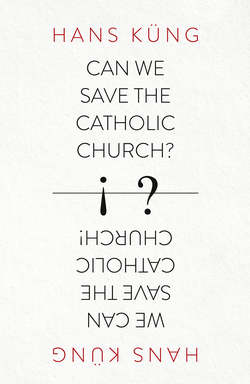Читать книгу Can We Save the Catholic Church? - Hans Kung - Страница 23
Diagnosis and Therapy
ОглавлениеGiven that the illness of the Church is hard to ignore, one might expect that within the worldwide Catholic episcopate, which together with the pope is responsible for the direction and ‘cure’ (possibly also the curative surgery) of the Church, there would be a widespread public debate about the principles which must guide such a radical cure, i.e. a debate which would go beyond mere superficial comments about mandatory celibacy and the like.
But we have not yet reached that point. In 2010, I had the same disappointing experience that Karl Rahner had had decades before, when he waited in vain for a response to his (confidential) 1970 letter to the German bishops. In 2010, I wrote an open letter to the bishops of the world. Copies were duly sent to each bishop, and the letter was widely publicized in the media worldwide and was endorsed by many readers. Not a single one of the approximately 5,000 bishops, some of whom I know personally, dared to answer, either in public or in private. Not only was there no positive reaction, but also no negative reaction, only complete and utter silence. Later on, I will attempt to explain the reasons for this silence.
Admittedly, people will ask me: what can individual bishops or theologians do, considering how gravely ill this Church is? I can only answer for myself: I am not a prophet or a miracle healer and I never wished to become a political agitator. So what can I do – I, who have always viewed myself as a professor of theology, philosophy and religious studies? I can, perhaps, offer services similar to those of a doctor or physician. Better yet – as suggested in the introduction to this book – those of a therapist who can help a critically ill patient, in this case the Church, not by offering superficial explanations and excuses but by providing a fundamental diagnosis that goes to the roots of the illness and by suggesting an effective therapy which will contribute a little to the patient’s recovery.
• The correct diagnosis (Greek: diágnosis = ‘discernment’): there must be no trivialization of the symptoms (‘It’s not as bad as it looks’) but no alarmist dramatics either (‘There is no cure!’). Instead, what is needed is an analysis of the history of the disease based on historical facts, a real pathogenesis which explains precisely how this centuries-old institution, the Catholic Church, got into such a lamentable condition. The medical term for this is aetiology: the search for the aitía, or cause.
• Effective therapies (Greek: therapeía = ‘service, care, medical treatment’): what is necessary is not therapies which merely treat the symptoms or isolated aspects of the disease; antipyretic medication alone will not get the Church back on its feet. What is required is a therapy that goes after the root causes, one which penetrates through all the layers of forgetting, repression and taboo to reach the true causes of the disease and fight the pathogenic factors or processes at work. Maybe even surgery will be indicated in certain areas to root out specific cancers.
At this point, many people will probably demur that this will take too much time and effort and is not worth the trouble.
